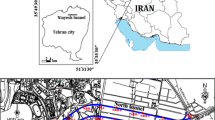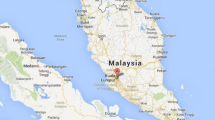Abstract
Liquefaction-induced settlement in saturated loose soils is a commonly geotechnical phenomenon resulted from the loss of its shear strength under moderate or high seismicity. This can have detrimental effects on building, infrastructure, and even human life. Therefore, predicting the settlement of ground caused by liquefaction plays a critical role in the geotechnical field. As the limited data for liquefaction-induced settlement obtained, an effective method should be applied to provide highly accurate prediction. The aim of this study is to propose a machine learning approach, namely multilayer perceptron (MLP), with a wide range of hyperparameters optimized by the Bayesian optimization method to predict liquefaction-induced settlement due to the Pohang earthquake in South Korea. The ground settlement and its correlation with different soil conditions were taken into account including unit weight, soil layer depth, standard penetration test blow count, and cyclic stress ratio. Moreover, other five well-known models, namely linear regression, support vector machine, robust regression, and polynomial regression, were performed to facilitate a comparison study. The experimental result indicates that while the high influence of all considerable variables on the ground settlement was obtained from the correlation coefficients, the soil layer depth factor had the highest one. Based on the Bayesian optimization, a greater prediction accuracy was observed from the proposed MLP model compared to other methods by using the evaluation metric of R-squared value. Furthermore, the developed model outperforms other machine learning methods proposed by previous studies in terms of predicting the soil settlement caused by liquefaction.








Similar content being viewed by others
References
Ahmad M, Tang X, Ahmad F (2021) Evaluation of liquefaction-induced settlement using random forest and REP tree models: taking pohang earthquake as a case of illustration. Nat. Hazards—Impacts Adjust. Resil., Noroozinejad Farsangi E (ed). IntechOpen
Bobde A, Narnaware V, Tawari S, Thomas A (2022) Robust time series forecasting via time differencing and stacking. In: 2022 Int. Conf. Smart Gener. Comput. Commun. Netw. SMART GENCON. IEEE, pp 1–8
Cao Z, Youd TL, Yuan X (2013) Chinese dynamic penetration test for liquefaction evaluation in gravelly soils. J Geotech Geoenviron Eng 139(8):1320–1333. https://doi.org/10.1061/(ASCE)GT.1943-5606.0000857
Doan N-P, Nguyen B-P, Park S-S (2023) Seismic deformation analysis of earth dams subject to liquefaction using UBCSAND2 model. Soil Dyn Earthq Eng 172:108003. https://doi.org/10.1016/j.soildyn.2023.108003
Doan N-P, Park S-S, Lee D-E (2020) Assessment of Pohang earthquake-induced liquefaction at Youngil-man port using the UBCSAND2 model. Appl Sci 10(16):5424. https://doi.org/10.3390/app10165424
Fang Y, Jairi I, Pirhadi N (2023) Neural transfer learning for soil liquefaction tests. Comput Geosci 171:105282. https://doi.org/10.1016/j.cageo.2022.105282
Frazier PI (2018a) A tutorial on bayesian optimization. arXiv
Frazier PI (2018b) A tutorial on Bayesian optimization. arXiv.org. Accessed 26 Dec 2023. https://arxiv.org/abs/1807.02811v1
Hashimoto F, Kakimoto A, Ota N, Ito S, Nishizawa S (2019) Automated segmentation of 2D low-dose CT images of the psoas-major muscle using deep convolutional neural networks. Radiol Phys Technol 12(2):210–215. https://doi.org/10.1007/s12194-019-00512-y
Ho TT, Kim G-T, Kim T, Choi S, Park E-K (2022) Classification of rotator cuff tears in ultrasound images using deep learning models. Med Biol Eng Comput 60(5):1269–1278. https://doi.org/10.1007/s11517-022-02502-6
Ho TT, Kim WJ, Lee CH, Jin GY, Chae KJ, Choi S (2023) An unsupervised image registration method employing chest computed tomography images and deep neural networks. Comput Biol Med 154:106612. https://doi.org/10.1016/j.compbiomed.2023.106612
Huang D, Cabral R, De la Torre F (2015) Robust regression. IEEE Trans Pattern Anal Mach Intell 38(2):363–375
Juang CH, Jiang T, Andrus RD (2002) Assessing probability-based methods for liquefaction potential evaluation. J. Geotech Geoenviron Eng 128(7):580–589. https://doi.org/10.1061/(ASCE)1090-0241(2002)128:7(580)
Kumar P, Sihag P, Sharma A, Pathania A, Singh R, Chaturvedi P, Mali N, Uday KV, Dutt V (2021) Prediction of real-world slope movements via recurrent and non-recurrent neural network algorithms: a case study of the Tangni landslide. Indian Geotech J 51(4):788–810. https://doi.org/10.1007/s40098-021-00529-4
Le T-T, Park S-S, Woo S-W (2022) Cyclic response and reconsolidation volumetric strain of sand under repeated cyclic shear loading events. J Geotech Geoenviron Eng 148(12):04022109. https://doi.org/10.1061/(ASCE)GT.1943-5606.0002919
Le T-T, Park S-S, Woo S-W, Tran L (2022b) Cyclic response and post-cyclic settlement of sand experiencing repeated earthquakes. CIGOS 2021 Emerg. Technol. Appl. Green Infrastruct., Lecture Notes in Civil Engineering, Ha-Minh C, Tang AM, Bui TQ, Vu XH, Huynh, DVK (eds). Springer Nature, Singapore, pp 1015–1023
Moeinossadat SR, Ahangari K, Shahriar K (2018) Control of ground settlements caused by EPBS tunneling using an intelligent predictive model. Indian Geotech J 48(3):420–429. https://doi.org/10.1007/s40098-017-0253-7
Muduli PK, Das SK (2014) CPT-based seismic liquefaction potential evaluation using multi-gene genetic programming approach. Indian Geotech J 44(1):86–93. https://doi.org/10.1007/s40098-013-0048-4
Murali Krishna A, Madhav MR, Kumar K (2014) Ground engineering with granular inclusions for loose saturated sands subjected to seismic loadings. Indian Geotech J 44(2):205–217. https://doi.org/10.1007/s40098-013-0085-z
Nguyen T-N (2023) A numerical study on the frictional resistance adjacent the pile tip in clayey sand. 990–1003
Nguyen T-N, Tran LV, Cuong PV, Tran TD (2023) Prediction of liquified soil settlement based on Artificial neural network. In: Proc. Third Int. Conf. Sustain. Civ. Eng. Archit., Lecture Notes in Civil Engineering. Springer Nature Singapore, Singapore, pp 1208–1214
Nguyen T-N, Tran V-T, Woo S-W, Park S-S (2022) Image segmentation of concrete cracks using SegNet. Intell. Things Technol. Appl., Lecture Notes on Data Engineering and Communications Technologies. Nguyen N-T, Dao N-N, Pham Q-D, Le HA (eds). Springer International Publishing, Cham, pp 348–355
Park S-S (2008) Liquefaction evaluation of reclaimed sites using an effective stress analysis and an equivalent linear analysis. KSCE J Civ Environ Eng Res 28(2C):83–94
Park S-S, Doan N-P, Nong Z (2021) Numerical prediction of settlement due to the Pohang earthquake. Earthq Spectra 37(2):652–685. https://doi.org/10.1177/8755293020957345
Park S-S, Ogunjinmi PD, Woo S-W, Lee D-E (2020) A simple and sustainable prediction method of liquefaction-induced settlement at Pohang using an artificial neural network. Sustainability 12(10):4001. https://doi.org/10.3390/su12104001
Park S-S, Tran D-K-L, Nguyen T-N, Woo S-W, Sung H-Y (2023) Effect of loading frequency on the liquefaction resistance of poorly graded sand. Adv. Geospatial Technol. Min. Earth Sci., Environmental Science and Engineering, Nguyen LQ, Bui LK, Bui X-N, Tran HT (eds). Springer International Publishing, Cham, pp 95–104
Park S-S, Tran V-T, Doan N-P, Hwang K-B (2022) Evaluation of damage level for ground settlement using the convolutional neural network. CIGOS 2021 Emerg. Technol. Appl. Green Infrastruct., Lecture Notes in Civil Engineering, Ha-Minh C, Tang AM, Bui TQ, Vu XH, Huynh DVK (eds). Springer Singapore, Singapore, pp 1261–1268
Pirhadi N, Hu J, Fang Y, Jairi I, Wan X, Lu J (2021) Seismic gravelly soil liquefaction assessment based on dynamic penetration test using expanded case history dataset. Bull Eng Geol Environ 80(10):8159–8170. https://doi.org/10.1007/s10064-021-02423-y
Ramchoun H, Amine M, Idrissi J, Ghanou Y, Ettaouil M (2016) Multilayer perceptron: architecture optimization and training. Int J Interact Multimed Artif Intell 4(1):26–30. https://doi.org/10.9781/ijimai.2016.416
Rana H, Babu GLS (2022) Object-oriented approach for landslide mapping using wavelet transform coupled with machine learning: a case study of Western Ghats, India. Indian Geotech J 52(3):691–706. https://doi.org/10.1007/s40098-021-00587-8
Robertson PK, (Fear) Wride C (1998) Evaluating cyclic liquefaction potential using the cone penetration test. Can Geotech J 35(3):442–459. https://doi.org/10.1139/t98-017
Sabbar AS, Chegenizadeh A, Nikraz H (2019) Prediction of liquefaction susceptibility of clean sandy soils using artificial intelligence techniques. Indian Geotech J 49(1):58–69. https://doi.org/10.1007/s40098-017-0288-9
Samui P, Sitharam TG (2011) Machine learning modelling for predicting soil liquefaction susceptibility. Nat Hazards Earth Syst Sci 11(1):1–9. https://doi.org/10.5194/nhess-11-1-2011
Shen S, Jiang H, Zhang T (2012) Stock market forecasting using machine learning algorithms. Dep. Electr. Eng. Stanf. Univ. Stanf. CA, pp 1–5
Singbal P, Chatterjee S, Choudhury D (2020) Assessment of seismic liquefaction of soil site at Mundra Port, India, using CPT and DMT field tests. Indian Geotech J 50(4):577–586. https://doi.org/10.1007/s40098-019-00395-1
Snoek J, Larochelle H, Adams RP (2012) Practical Bayesian optimization of machine learning algorithms. Adv. Neural Inf. Process. Syst. Curran Associates, Inc.
Tran TV, Nguyen B-P, Doan N-P, Tran D (2023) Performance of different CNN-based models on classification of steel sheet surface defects. J Eng Sci Technol JESTEC 18:554–562
Tran VT, To TS, Nguyen T-N, Tran TD (2022) Safety helmet detection at construction sites using YOLOv5 and YOLOR. Intell. Things Technol. Appl., Lecture Notes on Data Engineering and Communications Technologies. Nguyen N-T, Dao N-N, Pham Q-D, Le HA (eds). Springer International Publishing, Cham , pp 339–347
Turner R, Eriksson D, McCourt M, Kiili J, Laaksonen E, Xu Z, Guyon I (2021) Bayesian optimization is superior to random search for machine learning hyperparameter tuning: analysis of the black-box optimization challenge 2020. In: Proc. NeurIPS 2020 Compet. Demonstr. Track. PMLR, pp 3–26
Victoria AH, Maragatham G (2021) Automatic tuning of hyperparameters using Bayesian optimization. Evol Syst 12(1):217–223. https://doi.org/10.1007/s12530-020-09345-2
Waskom M (2021) Seaborn: statistical data visualization. J Open Source Softw 6(60):3021. https://doi.org/10.21105/joss.03021
Wu J, Chen X-Y, Zhang H, Xiong L-D, Lei H, Deng S-H (2019) Hyperparameter optimization for machine learning models based on Bayesian optimizationb. J Electron Sci Technol 17(1):26–40. https://doi.org/10.11989/JEST.1674-862X.80904120
Yang H, Chan L, King I (2002) Support vector machine regression for volatile stock market prediction. Intell. Data Eng. Autom. Learn.—IDEAL 2002, Lecture Notes in Computer Science, Yin H, Allinson N, Freeman R, Keane J, Hubbard S (eds). Springer Berlin Heidelberg, Berlin, Heidelberg, pp 391–396
Zhang W, Li H, Li Y, Liu H, Chen Y, Ding X (2021) Application of deep learning algorithms in geotechnical engineering: a short critical review. Artif Intell Rev 54(8):5633–5673. https://doi.org/10.1007/s10462-021-09967-1
Funding
This work was supported by a National Research Foundation of Korea (NRF) grant funded by the Korean government (MSIT) (No. NRF-2018R1A5A1025137).
Author information
Authors and Affiliations
Corresponding authors
Ethics declarations
Conflict of interest
The authors declare no conflict of interest.
Additional information
Publisher's Note
Springer Nature remains neutral with regard to jurisdictional claims in published maps and institutional affiliations.
Rights and permissions
Springer Nature or its licensor (e.g. a society or other partner) holds exclusive rights to this article under a publishing agreement with the author(s) or other rightsholder(s); author self-archiving of the accepted manuscript version of this article is solely governed by the terms of such publishing agreement and applicable law.
About this article
Cite this article
Van Nguyen, N., Van Le, L., Nguyen, TN. et al. Prediction of Liquefied Soil Settlement Using Multilayer Perceptron with Bayesian Optimization. Indian Geotech J (2024). https://doi.org/10.1007/s40098-024-00894-w
Received:
Accepted:
Published:
DOI: https://doi.org/10.1007/s40098-024-00894-w




